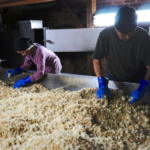【47 Hakko Nara】奈良の奈良漬け Narazuke 〜古代から受け継がれる漬物文化の最高峰〜
古代から受け継がれる漬物文化の最高峰
日本史において最も早い時期に登場する由緒正しい漬物。平城京の時代から朝廷への貢物として重宝されていたようだ。ウリやナス、ひょうたんなどを酒粕のなかに漬け込んでいく。特筆すべきは、食材の特性にあわせて何度も漬床を変えながら数年間かけて熟成させていく過剰なまでの手間だ。これによりありふれた野菜が高貴な香りや甘味のある高級食品に変身する。発酵食品の錬金術のお手本と言えよう。
The pickles that rank in the highest echelon of pickling culture inherited from ancient Japan
Narazuke is the first pickles that appears in ancient Japanese literature. It used to be treasured as a present offered to the Imperial Court since the imperial family resided in Heijokyo (ancient name of Nara). Vegetables like melon cucumber, eggplant and gourd were picked in sake lees. Particularly noteworthy is the overabundant amount of care devoted in the making. The pickling bed is changed repeatedly according to the characteristics of the vegetables that are pickled. The total aging period spans over multiple years. Through this laborious process, the vegetables reach their maturity, evolving into a premium form of food that features a deeply concentrated flavor augmented by well-balanced natural sweetness. This is indeed the alchemical model of the rich fermented food catalog developed in Japan.
どう作って食べるか / HOW TO MAKE & EAT
❶季節の野菜を下処理し、塩で仮漬けする。
❷半年ほど熟成させた酒粕と塩をまぜて漬床として、食材を漬け込む。
❸食材の特性にあわせて漬床を何度か漬け変えながら2〜5年ほど熟成させる。
❶After completing the pretreatment of seasonal vegetables, rest them in salt for a tentative period.
❷Create a pickling bed by mixing salt and sake lees that have been aged for about half a year. Place the salted vegetables in this bed.
❸Change the pickling bed repeatedly according to the characteristics of the vegetables that are pickled and wait for the vegetables to age and reach their maturity in the repeatedly updated pickling bed for two to five years.
香の物として
As a pickles
▶食べられている地域 / Regions where it is eaten
日本全国
Nationwide
▶微生物の種類 / Types of microorganisms
酵母、乳酸菌類
Yeast and lactic acid bacteria
